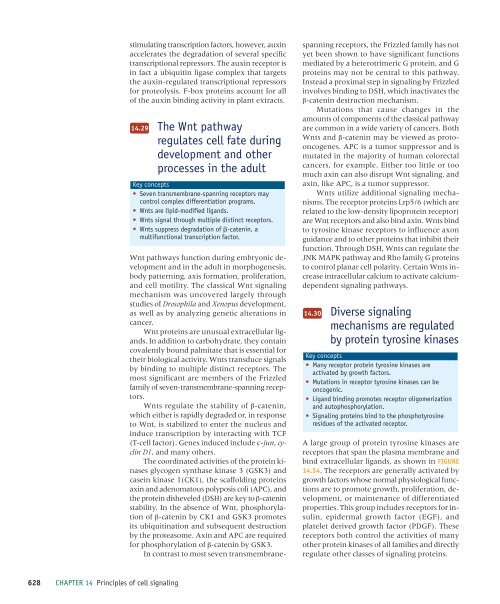Principles of cell signaling - UT Southwestern
Principles of cell signaling - UT Southwestern
Principles of cell signaling - UT Southwestern
Create successful ePaper yourself
Turn your PDF publications into a flip-book with our unique Google optimized e-Paper software.
39057_ch14_<strong>cell</strong>bio.qxd 8/28/06 5:11 PM Page 628<br />
stimulating transcription factors, however, auxin<br />
accelerates the degradation <strong>of</strong> several specific<br />
transcriptional repressors. The auxin receptor is<br />
in fact a ubiquitin ligase complex that targets<br />
the auxin-regulated transcriptional repressors<br />
for proteolysis. F-box proteins account for all<br />
<strong>of</strong> the auxin binding activity in plant extracts.<br />
14.29<br />
The Wnt pathway<br />
regulates <strong>cell</strong> fate during<br />
development and other<br />
processes in the adult<br />
Key concepts<br />
• Seven transmembrane-spanning receptors may<br />
control complex differentiation programs.<br />
• Wnts are lipid-modified ligands.<br />
• Wnts signal through multiple distinct receptors.<br />
• Wnts suppress degradation <strong>of</strong> -catenin, a<br />
multifunctional transcription factor.<br />
Wnt pathways function during embryonic development<br />
and in the adult in morphogenesis,<br />
body patterning, axis formation, proliferation,<br />
and <strong>cell</strong> motility. The classical Wnt <strong>signaling</strong><br />
mechanism was uncovered largely through<br />
studies <strong>of</strong> Drosophila and Xenopus development,<br />
as well as by analyzing genetic alterations in<br />
cancer.<br />
Wnt proteins are unusual extra<strong>cell</strong>ular ligands.<br />
In addition to carbohydrate, they contain<br />
covalently bound palmitate that is essential for<br />
their biological activity. Wnts transduce signals<br />
by binding to multiple distinct receptors. The<br />
most significant are members <strong>of</strong> the Frizzled<br />
family <strong>of</strong> seven-transmembrane-spanning receptors.<br />
Wnts regulate the stability <strong>of</strong> β-catenin,<br />
which either is rapidly degraded or, in response<br />
to Wnt, is stabilized to enter the nucleus and<br />
induce transcription by interacting with TCF<br />
(T-<strong>cell</strong> factor). Genes induced include c-jun, cyclin<br />
D1, and many others.<br />
The coordinated activities <strong>of</strong> the protein kinases<br />
glycogen synthase kinase 3 (GSK3) and<br />
casein kinase 1(CK1), the scaffolding proteins<br />
axin and adenomatous polyposis coli (APC), and<br />
the protein disheveled (DSH) are key to β-catenin<br />
stability. In the absence <strong>of</strong> Wnt, phosphorylation<br />
<strong>of</strong> β-catenin by CK1 and GSK3 promotes<br />
its ubiquitination and subsequent destruction<br />
by the proteasome. Axin and APC are required<br />
for phosphorylation <strong>of</strong> β-catenin by GSK3.<br />
In contrast to most seven transmembrane-<br />
spanning receptors, the Frizzled family has not<br />
yet been shown to have significant functions<br />
mediated by a heterotrimeric G protein, and G<br />
proteins may not be central to this pathway.<br />
Instead a proximal step in <strong>signaling</strong> by Frizzled<br />
involves binding to DSH, which inactivates the<br />
β-catenin destruction mechanism.<br />
Mutations that cause changes in the<br />
amounts <strong>of</strong> components <strong>of</strong> the classical pathway<br />
are common in a wide variety <strong>of</strong> cancers. Both<br />
Wnts and β-catenin may be viewed as protooncogenes.<br />
APC is a tumor suppressor and is<br />
mutated in the majority <strong>of</strong> human colorectal<br />
cancers, for example. Either too little or too<br />
much axin can also disrupt Wnt <strong>signaling</strong>, and<br />
axin, like APC, is a tumor suppressor.<br />
Wnts utilize additional <strong>signaling</strong> mechanisms.<br />
The receptor proteins Lrp5/6 (which are<br />
related to the low-density lipoprotein receptor)<br />
are Wnt receptors and also bind axin. Wnts bind<br />
to tyrosine kinase receptors to influence axon<br />
guidance and to other proteins that inhibit their<br />
function. Through DSH, Wnts can regulate the<br />
JNK MAPK pathway and Rho family G proteins<br />
to control planar <strong>cell</strong> polarity. Certain Wnts increase<br />
intra<strong>cell</strong>ular calcium to activate calciumdependent<br />
<strong>signaling</strong> pathways.<br />
14.30<br />
Diverse <strong>signaling</strong><br />
mechanisms are regulated<br />
by protein tyrosine kinases<br />
Key concepts<br />
• Many receptor protein tyrosine kinases are<br />
activated by growth factors.<br />
• Mutations in receptor tyrosine kinases can be<br />
oncogenic.<br />
• Ligand binding promotes receptor oligomerization<br />
and autophosphorylation.<br />
• Signaling proteins bind to the phosphotyrosine<br />
residues <strong>of</strong> the activated receptor.<br />
A large group <strong>of</strong> protein tyrosine kinases are<br />
receptors that span the plasma membrane and<br />
bind extra<strong>cell</strong>ular ligands, as shown in FIGURE<br />
14.34. The receptors are generally activated by<br />
growth factors whose normal physiological functions<br />
are to promote growth, proliferation, development,<br />
or maintenance <strong>of</strong> differentiated<br />
properties. This group includes receptors for insulin,<br />
epidermal growth factor (EGF), and<br />
platelet derived growth factor (PDGF). These<br />
receptors both control the activities <strong>of</strong> many<br />
other protein kinases <strong>of</strong> all families and directly<br />
regulate other classes <strong>of</strong> <strong>signaling</strong> proteins.<br />
628 CHAPTER 14 <strong>Principles</strong> <strong>of</strong> <strong>cell</strong> <strong>signaling</strong>
















